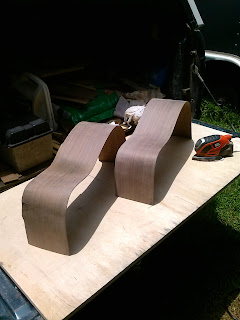It's been a month or more since my last post in Tailgate Guitar. I've been building but not writing. The guitar is almost finished but todays post is about the neck and related components.
The neck supports the tuners, the fret board, and the truss rod. The neck construction required a lot of measuring and shaping. Most of the research I did showed builders using chisels and shavers to carve the neck. I tried using chisels and a spokeshave but ultimately most of tailgate guitar's neck was shaped on a belt sander. I just liked it better. The neck began when I found an old piece of crown molding leaning against the wall in my mother's garage. It had obviously been there for years and it looked like mahogany. I took it home, cut the length in half, then glued the flat sides back together with a strip of purple heart (a naturally purple colored wood) in the middle. Now it's half the length and twice the width and measured out just right. I had a block of walnut that I wanted to use for the heel and the peghead so I cut appropriate sized pieces and clamped and glued them to the mahogany.
I decided to build a bolt on neck rather than a dovetail joint so that future removal would be easier if ever necessary. This required a mortise and tenon joint that I created with the table saw. This is the first time that I've ever done anything like this. I didn't know what a mortise and tenon joint was. That's one of the reasons why I've enjoyed this project so much. Learning is fun.
I'd never heard of a truss rod before, either. I now know that most stringed instruments have them. That's because the strings exert a lot of tension on the neck, somewhere around 150 pounds of pressure. So... steel truss rods are imbedded in the neck to counteract this force. If you look inside the sound hole of your acoustic guitar you will probably see the end of your truss rod. It should have a hex head so that you can use an allen wrench to adjust it. Or... the adjustment end might be under a small cover found on the peghead right behind the nut. The idea is that over time the strings pull the peghead up towards the body of the guitar, creating too much space between the strings and the fret board. The truss rod can be adjusted to bring it back.
The fret board is easily the most critical part of the neck. The frets must be located properly or the guitar won't play in tune. Fortunately, smarter people have already figured this out. I found a fret placement calculator at stewmac.com, a luthier supply company. They tell you the correct distance from the nut to each fret, all 20 of them, to the 1/1000 of an inch. I could only measure to 1/64 of an inch so I did the best I could and double checked the placement by comparing it to my old guitar. The quality of my work will be made known after I string this thing up for the first time. Which shouldn't be too much longer.
two pieces of mahogany and a strip of purple heart will become the neck
I found these bolts and barrel nuts in the furniture
hardware section at the hardware store
the mortise and tenon joint
using the router table to cut the groove for the truss rod
truss rod installed in the neck
This piece of wood will be the clamping caul for the frets. The fret board is not flat, it is radiused so I placed sandpaper over it and ran the caul back and forth until it had a corresponding radius. This is important because I'm installing the frets with epoxy and I will need even clamping pressure.
frets lined up and ready to be installed
painters tape will keep epoxy squeeze out off of the fret board
I wanted to inlay a star in the peghead to complement the design in the body
I used electricians tape on a 1/8" drill bit to mark the proper depth,
then took out as much wood as I could
a chisel and exacto knife did the rest
the star glued in place and sanded flush
I also inlaid diamonds cut from poplar in the purple heart fret board.
Most fret boards are made from ebony or rosewood, but I didn't have any.
A wood hardness chart showed purple heart
to be equal in hardness to rosewood which was cool because the
purple heart worked perfect for the overall design.











































